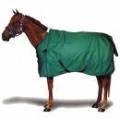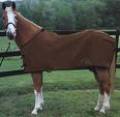
Horse Blankets Reviews
|
Equine Lordosis
Equine Lordosis
Equine lordosis, more commonly called swayback is a condition that looks just like it sounds. Instead of a nice straight line from the the withers to the hip a horse with a swayed back has a spine that dips towards the ground.
The average horse person looks at horse plagued with a swayed back and automatically jumps to two conclusions. The fist the conclusion the person jumps to is that the horse is a senior citizen, if not completely past their useful years they are close to it. The second conclusion they jump to is that they horse's spine was damaged through years of hard riding with an improper conclusion.
I know from personal experience that these misconceptions are not always true. I know this because I ride a young warm blood gelding, Spooner, who has been plagued with a swayed spine since he was a yearling. Although this gelding will be plagued with a swayback for the rest of his life it has in know way affected his working career. He has started a successful career as a show jumper and spends a great deal of his time schooling complicated dressage movements. He is
athletic despite his condition and I've never come across a more willing partner.
While he was an undergraduate at the University of Kentucky Dr. Patrick Gallagher noticed something interesting about horses who had equine lordosis. Humans and dogs that were diagnosed with lodosis were severely disabled while horses with the same condition where able to be worked and trained, something Spooner has proven to me time and time again.
It is estimated that only approximately one percent of the worlds horse population is diagnosed with equine lordosis. Because so few horses suffer from the condition very few researchers are willing to take the time to study it, preferring to spend their time on things like founder and colic. Dr. Gallagher became interested in the condition when he noticed that his father's Saddlebreds seemed to run a higher risk of developing equine lordosis then other breeds.
During his graduate studies Dr. Gallhager started to notice that there was a direct correlation between a young horses skeletal structure and the chances of them developing lordosis. Although the dip in the spine was not normally obvious when the foal was born. As the foal grew and developed the back started to sway. The inverted curve of the spine normally stabilized when the foal finished growing. At six years old Spooner's spine is just starting to stabilize (foals from Spooner's family tend to grow taller until they are about six years old and several of them don't completely broaden until they are eight).
The next thing Dr. Gallagher looked at was the foals pedigree and genetic make-up. He noticed that certain family trees did have a greater chance of developing lorodisis then others but was unable to isolate the exact gene responsible.
Perhaps the most important thing Dr. Gallaghers research proved was something I learned from Spooner. The back does not affect their work habits. Swaybacked broodmares have no trouble carrying a foal to term, while racehorses with lorodisis are not typically as fast as their straight backed counterparts the average performance horse appears to be unhampered by the inverted spine (Spooner has a hitch in one leg but that could be an injury instead of his back).
Gallagher and I are in complete agreement that fitting a saddle to the swaybacked horse takes a little thought. I have found that if I use my simple cloth square-cut dressage blanket under a thick barrel racing blanket my saddle not only fits well but I am also able to minimize the amount I am jarred by Spooner's bouncing trot.
 |
 |
 |
Choosing Tack For The Dressage Horse
When Do You Need Horse Equipment
Why Horse Blankets Are Handy With Splints
Why Leg Wraps And Horse Blankets Are Handy
Horse Tack Purchasing A Western Saddle Blanket
More Horse Blankets Articles
... mask that covers your horses nose all you need to do is rub your horses nose with sunscreen that you can purchase at your local drugstore. Some horse owners, especially ones who are interested in showing, try to prevent the sun from damaging their horses coat by keeping them inside during the day time ...
... local feed store. Many magazines that advertise western or Indian related items will carry horse blankets. Some of the bigger, well-known flea markets also are sure to have someone dealing in horse blankets. Some of the companies that sell western items and equipment are American Saddlery, Cottage Craft, ...
A Peek Into The History Of Horse Blankets
... woven with no art in the centers. These would be covered by the saddles, making the extra effort impractical as they could be out-of-sight when used by the rider. The horse blanket could be hung on a wall in a log cabin and bring out a surreal sense of its natural beauty. Photographs and posters or wall ...
Why Horse Blankets Are Handy With Splints
... room, a horse brush, treats, careful training, and lots of love and attention? You need veterinary care. One of the things a horse can encounter includes something called splints. There are splint bones, not to be confused with the injury itself; however, splints do affect the area of the splint bones. ...

|
| Copyright © 2006-2012 Internet Marketing Tools, All Rights Reserved |